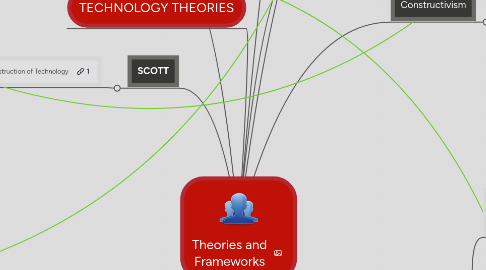
1. SCOTT
1.1. Social construction of Technology
1.1.1. Science and technology study
1.1.2. social constructivist propose that human actions affect technology, in fact from a constructivist approach people learn by interacting with their environment and are active learners
1.1.3. Explores the reasons for the use of technology based on social feedback
2. Media Ecology
2.1. It is the study of media as environments. It studies how media affect society and peoples lives.
2.2. Teacher should consider the importance of the use of technology to improve teaching and learning. Technology if used with appropriate training can help teacher to meet the diverse needs of students and offer students and teachers multiple ways of expression, engagement and representation.
3. TECHNOLOGY THEORIES
4. PHIILOSOPHY OF TECHNOLOGY
4.1. Teacher personal philosophy about the use of technology in the classroom
4.2. It is similar to the philosophy of teaching: teacher's belief, values and guiding principles to personal approaches to teaching practices, strategies, classroom management and so on
4.2.1. Philosophy of Teaching is also based on our knowledge of learning theories and the application of the theory or theories that resonate better with our beliefs
4.3. Here are some questions that teachers my consider when creating their philosophy of technology
4.3.1. Do I believe that the use of technology can help me become a more effective teacher?
4.3.2. How can the use of technology help students with special needs?
4.3.3. How can technology be used safely in the classroom?
5. Cognitivism
5.1. Cognitive Load Theory
5.2. Information processing theory explains the process of working memory, long term memory and schemas
5.3. working memory: stores and uses visual images and auditory info for a limited amount of time
5.4. Long term memory: store information for an unlimited amount of time. Successful retrieving of information depends on how the information was learned in the first place and how many connections to previous knowledge the person has made.
5.5. schemas: mental system, organized thoughts, behaviour, ideas, knowledge
5.6. People are consired active learners; they are not just responding to learnt stimuli as in classical conditioning
5.7. teachers should present information in chunks, small bits of meaningful info, use repetition, practice and consider students background knowledge by forming connection between learnt materials and new materials. This will help to transfer the information from working memory to long term memory
5.8. teachers should be aware that presenting too many information at once especially when the student doesn't have background knowledge leads to working memory overload and no learning can occur.
6. Constructivism
6.1. view learners has having an active role in understanding and making sense of information by interacting with their environment.
6.2. teachers adopting a constructivist approach should engage students in complex, realistic, meaningful learning tasks, authentic tasks, should provide support and have a role of facilitator allowing the students to take ownership of their leaning, should also facilitate collaboration through group work, and encourage students to find solutions to problems through the use of inquiry, problem based and discover learning. Also, the teacher should provide constructive feedback.
6.3. Constructivist theory similar to Cognitive theory see the learner as being active in the learning process
7. Behaviourism
7.1. Explains that external events affect learning and changes in behaviour.
7.2. Classical Conditioning: relating automatic responses to stimuli. Neutral stimulus, Unconditioned stimulus;Unconditioned response; conditioned stimulus, conditioned response. Discovered by Ivan Pavlov.
7.3. current behaviour is modified by linking it to new stimuli
7.4. Operant Conditioning: Strengthening or weakening a behaviour through consequences Positive and negative reinforcements increases the chances that a behaviour will occur again.
7.5. Positive and negative reinforcements increases the chances that a behaviour will occur again. Positive and negative punishment decreases the chances that a behaviour will occur again.
7.6. A teacher can use a behavioural approach for classroom management, rewards and punishments to shape students behaviours, to extrinsically motivate students, to model appropriate behaviour or skills and teach through repetition
8. LEARNING THEORIES
9. TPACK
9.1. Technological Pedagogical Content knowledge is a structure that highlight the relationship of technological, pedagogical and content knowledge to support the integration of the use of technology for effective teaching.
9.1.1. Technological knowledge: knowledge of technology use such programs and software tools
9.1.2. Pedagogical Knowledge: knowledge of the methods of teaching and learning
9.1.3. Content Knowledge: knowledge of the subject matter that is being taught
9.2. Application of TPACK depends on the environment and takes into consideration that every situation is different and requires a different TPACK approach
9.2.1. Teachers
9.2.2. Grade Level
9.2.3. Type of school
9.2.4. Demographic
9.2.5. Culture
9.3. TPACK can help teachers balance the 3 type of knowledge in order to teach effectively with the use of technology
9.3.1. Teaching following the TPACK framework can create a dynamic student-centred environment
